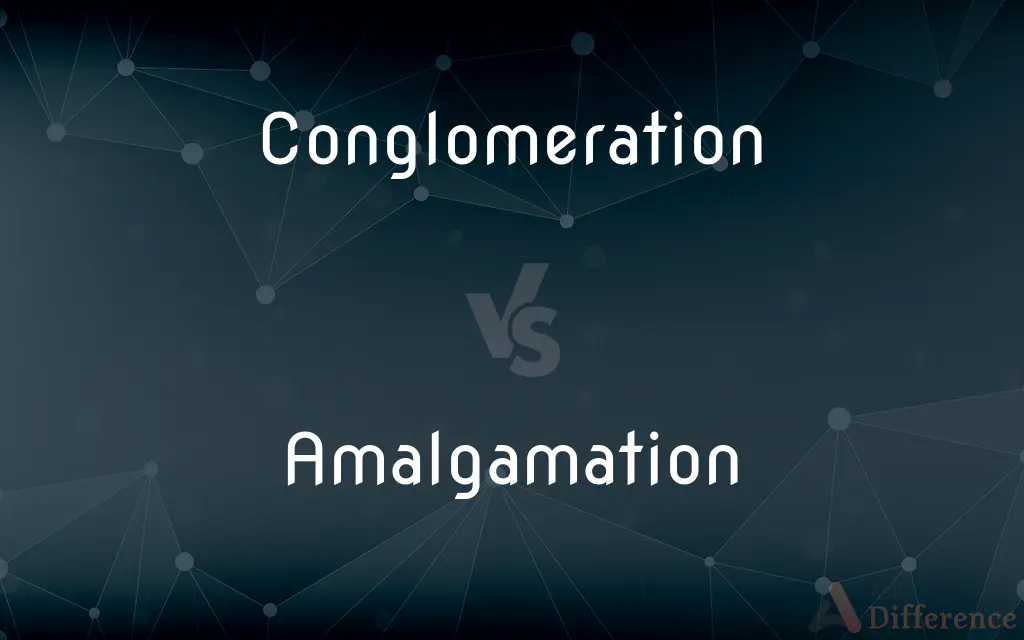Conglomeration vs. Amalgamation — What's the Difference?
By Urooj Arif & Fiza Rafique — Updated on March 21, 2024
A conglomeration refers to a large, multi-industry corporation formed by mergers, whereas amalgamation involves the merging of companies into a new entity, often in similar industries.

Difference Between Conglomeration and Amalgamation
Table of Contents
ADVERTISEMENT
Key Differences
Conglomeration involves the combination of multiple businesses or companies across different industries under one corporate group, focusing on diversification to minimize risks. On the other hand, amalgamation is the process where two or more companies, usually within the same or related industries, merge to form a new entity, with the aim of strengthening market position or expanding capabilities.
In a conglomeration, the constituent companies may operate independently, maintaining their brand identity while benefiting from shared resources and a unified corporate strategy. Whereas in an amalgamation, the merging entities often dissolve their previous identities to create a new, unified brand and operational structure, reflecting the integration of their assets, resources, and markets.
The strategic intent behind conglomeration is diversification, which helps to protect the parent corporation from industry-specific downturns by spreading its interests across unrelated sectors. Amalgamation, however, is driven by the desire to achieve synergies, improve efficiency, or enhance competitiveness in a particular market or industry.
Financially, conglomeration allows a corporation to allocate resources and capital across a wide range of industries, potentially tapping into new markets and revenue streams. Amalgamation focuses on consolidating financial and operational strengths to achieve cost reductions, increased revenue, and stronger market presence within a specific sector.
The regulatory and legal frameworks surrounding conglomerations and amalgamations can also differ significantly, with conglomerations often facing scrutiny over their potential to create monopolistic powers in diverse markets, while amalgamations may be closely examined for their impact on competition within a specific industry.
ADVERTISEMENT
Comparison Chart
Definition
A corporation consisting of multiple businesses across various industries.
The merging of companies into a new entity, often within the same industry.
Strategic Intent
Diversification across industries.
Strengthening market position or expanding capabilities within an industry.
Brand Identity
Companies may retain individual identities.
Merging entities often create a new, unified brand.
Financial Objective
Access to new markets and diversified revenue streams.
Consolidation of financial and operational strengths.
Regulatory Focus
Potential monopolistic powers across markets.
Impact on comp
Compare with Definitions
Conglomeration
The action of forming a conglomerate corporation.
The company's growth was significantly accelerated by its conglomeration strategy.
Amalgamation
A process where companies consolidate to form a new organization with a unified strategy.
The board approved the amalgamation to achieve greater efficiency.
Conglomeration
A multi-industry corporation formed from the combination of unrelated businesses.
The conglomeration owns companies in the technology, healthcare, and entertainment sectors.
Amalgamation
The merging of two or more companies into a new entity, usually in the same industry.
The amalgamation of the two firms created a new market leader.
Conglomeration
A large, diversified holding company.
He works for a conglomeration with interests in various industries.
Amalgamation
The unification of company resources, staff, and operations into a single entity.
The successful amalgamation resulted in a stronger presence in the industry.
Conglomeration
The process of companies merging or being acquired across different industries.
Their strategy involves the conglomeration of diverse businesses to minimize risk.
Amalgamation
A strategy to enhance competitiveness through merging.
The companies chose amalgamation as their strategy to combat the increasing competition.
Conglomeration
A corporate group that operates in multiple sectors.
The conglomeration reported increased profits due to its diversified portfolio.
Amalgamation
The creation of a new company through the combination of existing ones.
They underwent an amalgamation to streamline operations and reduce costs.
Conglomeration
The act or process of conglomerating.
Amalgamation
The act of amalgamating or the condition resulting from this act.
Conglomeration
The state of being conglomerated.
Amalgamation
A consolidation or merger, as of several corporations.
Conglomeration
An accumulation of miscellaneous things.
Amalgamation
The production of a metal alloy of mercury.
Conglomeration
That which consists of many previously separate parts.
Amalgamation
The process of amalgamating; a mixture, merger or consolidation.
Conglomeration
An instance of conglomerating, a coming together of separate parts.
Amalgamation
The result of amalgamating; a mixture or alloy.
Conglomeration
The act or process of gathering into a mass; the state of being thus collected; collection; accumulation.
Amalgamation
(specifically) The production of an alloy of mercury and another metal.
Conglomeration
That which is conglomerated; a mixed mass; a hodgepodge.
Amalgamation
(obsolete) The intermarriage and interbreeding of different ethnicities or races.
Conglomeration
A rounded spherical form
Amalgamation
The act or operation of compounding mercury with another metal; - applied particularly to the process of separating gold and silver from their ores by mixing them with mercury.
Conglomeration
A sum total of many heterogenous things taken together
Amalgamation
The mixing or blending of different elements, races, societies, etc.; also, the result of such combination or blending; a homogeneous union.
Conglomeration
An occurrence combining miscellaneous things into a (more or less) rounded mass
Amalgamation
The combination of two or more commercial companies
Common Curiosities
Can a conglomeration involve companies in the same industry?
While it can, the essence of a conglomeration is diversification, so it typically involves multiple industries.
Why do companies choose amalgamation?
Companies amalgamate to strengthen their market position, achieve operational efficiencies, and expand their capabilities within an industry.
How does a conglomeration affect competition?
Conglomerations can affect competition across different markets by leveraging diversified resources, though their main industries may remain competitive.
Is international expansion easier for conglomerates or amalgamated companies?
Conglomerates may find it easier to expand internationally due to their diversified presence and financial resources, while amalgamated companies might focus on deepening their presence within specific regional markets.
How do regulatory bodies view amalgamations?
Regulatory bodies scrutinize amalgamations for their potential to reduce competition within an industry, ensuring they do not harm consumer interests.
What is the primary goal of a conglomeration?
The primary goal is diversification, spreading risks and opportunities across different industries.
What happens to company brands in an amalgamation?
In an amalgamation, company brands often merge into a new identity to reflect the unified operation and strategy.
Are amalgamations common in specific industries?
Amalgamations are more common in industries where synergies and scale can significantly impact competitiveness, such as finance, technology, and manufacturing.
What legal considerations are important in an amalgamation?
Legal considerations include antitrust laws, regulatory approvals, and ensuring that the merger does not unfairly restrict competition within the industry.
How do stakeholders benefit from a conglomeration?
Stakeholders benefit from reduced risks and potentially increased opportunities for growth across diverse sectors.
Can a company be part of both a conglomeration and an amalgamation?
Yes, a company can be part of a conglomeration and later enter into an amalgamation with companies within a specific industry segment of the conglomerate.
Can an amalgamation fail?
Yes, if the integration process is poorly managed or if the anticipated synergies do not materialize, amalgamations can fail to deliver expected benefits.
Do consumers benefit from conglomerations or amalgamations?
Consumers can benefit from increased product and service options and potentially lower prices due to efficiencies gained through both business strategies.
How does employee culture change in an amalgamation?
Amalgamation often requires merging different corporate cultures, which can be challenging but is essential for the new entity's success.
What is the impact of a conglomeration on innovation?
Conglomerates have the resources to invest in innovation across a broad spectrum of industries, potentially leading to cross-industry innovations.
Share Your Discovery

Previous Comparison
Herring vs. Shad
Next Comparison
Amoxicillin vs. OxacillinAuthor Spotlight
Written by
Urooj ArifUrooj is a skilled content writer at Ask Difference, known for her exceptional ability to simplify complex topics into engaging and informative content. With a passion for research and a flair for clear, concise writing, she consistently delivers articles that resonate with our diverse audience.
Co-written by
Fiza RafiqueFiza Rafique is a skilled content writer at AskDifference.com, where she meticulously refines and enhances written pieces. Drawing from her vast editorial expertise, Fiza ensures clarity, accuracy, and precision in every article. Passionate about language, she continually seeks to elevate the quality of content for readers worldwide.
















































